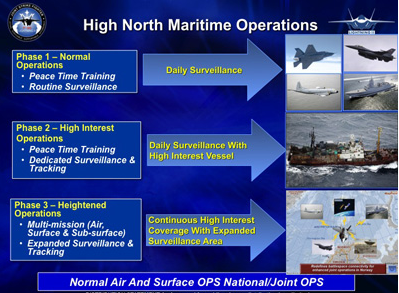6/15/12: by Robbin Laird
I personally have done quite a lot of work on Arctic security. And in the course of working on the Arctic and dealing with Norwegians, Canadians and Danes, the F-35 and in the Norwegian case the Aegis systems came into play as well. And in a piece which I wrote in 2010, I focused in part on how the F-35 might fit into the Norwegian solution set to shape an effective overall Arctic security strategy. This thinking certainly has been part of the Norwegian thinking in starting down the F-35 path.
In this article, I leveraged a couple of Lockheed Martin briefing slides to highlight such a perspective.
An “F-35-Enabled Arctic Task Force” As Part of the Puzzle?
Lockheed Martin has provided a briefing that lays out how the F-35 as a “flying combat system” working with surface assets can provide for Arctic security missions for Norway.
The key really is the ability to integrate an aircraft with an on-board database of intelligence and to be able to distribute this intelligence to other elements of an Arctic “task force” to protect Norwegian interest.
The slides below lay out a notional area of interest to protect from a Norwegian point of view.
These areas of interest will require Norwegian investments over the next thirty years in capabilities to shape and protect their engagement. Norway could stovepipe the acquisition of key assets with little regard to the integration of those assets, and could do so in virtual isolation from its allies. Alternatively, Norway could have significant integration among the assets it acquires with maximum interoperability with its allies, notably with its Arctic allies. In this light, the F-35 could become an important piece for solving the co-opetition puzzle.
The graphic (in the article) identifies the different operations, which could be pursued sequentially or simultaneously by an F-35 enabled Arctic “task force.” The advantage of the F-35 is that with a small number of aircraft able to integrate across the maritime and air spectrum, the “task force” could be small indeed.
In any case, nations will acquire new capabilities to deal with the ambigious Arctic future. Comments made by one Arctic expert as quoted by Jane’s Navy International (JNI) provide a good characterization of the fluidity of the evolving Arctic situation:
“Arctic expert Dr Rob Huebert, associate director of the Centre for Military and Strategic Studies at the University of Calgary, says that the main challenge until recently was getting people to take Arctic issues seriously. “Now the problem is trying to define the threat,” he says. The main concern is uncertainty, but he believes that, within this context, there are three variables: climate change, resource potential and changing geo-political reality. What makes the situation more complicated is that analysts are unable to ascertain how the three variables will interact. “Under one scenario, climate change and resource development [will make] northern resources more accessible, but when you start developing those resources, you add to climate change,” says Huebert. “The Russians are rebuilding their military capabilities through their petro dollars, and guess where their future petro dollars are coming from? The North.” He adds: “My feeling is that we’re in for a really complicated situation and if you get people doing dumb things, it can get real ugly, real fast, because it’s the interface of the politics that gets things out of control.”
For the original article
https://www.sldinfo.com/emerging-strategic-challenges-the-case-of-arctic-co-opetition/



